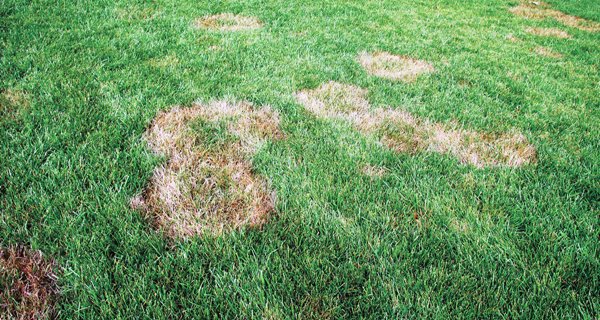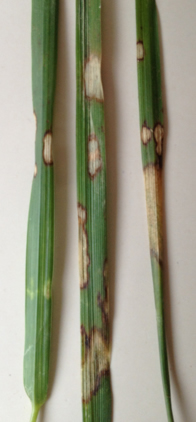Years ago, scientists took a soil sample from deep below the ice in Antarctica and found something: brown patch.
Brown patch is a fungus causing brown circles in your lawn during the hot humid months of summer. Why did they find it in Antarctica then? Because brown patch can remain dormant for many years. The reason you notice it now is because it has become active, the good news is we can control it!
Understanding Brown Patch Fungus
At NaturaLawn of America, we understand that having brown patches on your lawn can be frustrating, and we are here to help. Our team of lawn care experts has put together a comprehensive guide on how to get rid of brown patches on your lawn, so you can enjoy a lush and healthy lawn all year round.
What Is Brown Patch Fungus?
Brown patch (Rhizoctonia solani) is a soil-living fungus which becomes active in humid months where temperatures reach the mid 80’s during the day, and mid to upper 70’s overnight.
Like the name would lead you to believe, brown patch causes a brownish discoloration of your turfgrass. More specifically, it starts out with lesions on the grass blades (shown here).
As brown patch develops, these lesions spread to cover the entire grass blade, causing thinning and matting of the turf. On shorter lawns, these patches may appear to have a "smoke ring" of dark gray around the outer edge. These circular or irregular brown patches can range in size from a few inches to several feet in diameter.
What Causes Brown Patch In Your Lawn?
If your lawn is wet going into the evening, the moisture can encourage the growth of the brown patch fungi. In addition, this disease can be more severe in areas which have restricted air movement, such as between houses, fences, or plants.
How to Prevent Brown Patch In Your Lawn
Best Watering Practices for Lawn Health
As previously stated, this particular turf disease will be most successful if your lawn is wet going into the evening and night. To prevent brown patch water your lawn in the early morning, preferably between 3:00am - 8:00am.
Unobstructed Airflow
Proper airflow is also crucial to preventing brown patch. As previously stated, brown patch prefers moist areas; so if you increase airflow in troublesome areas, it will help to dry off your turfgrass. Do your best to increase circulation in these areas by removing unnecessary objects or foliage in your backyard. Also, a proper regiment of aeration will help to strengthen your lawn and increase airflow to the root zone.
Proper Mowing Goes a Long Way: Mowing Techniques to Prevent Lawn Diseases
The simplest thing to help your grass combat this, and any turf disease, is mowing your lawn properly. We recommend homeowners to:
- Sharpen mower blades: dull blades cause wounds through which disease may spread. Learn more about why sharp mower blades are imporant.
- It is recommended to not mow the lawn when it is wet. Here are some ways to test whether your lawn needs to be watered.
- Mow at the proper height—lawns mowed at the mower’s highest setting stand up to stress better.
Read our top lawn mowing tips.
Natural Remedies for Treating Brown Patches
At the point where you need to control an outbreak of brown patch, don’t reach for a control material right away, as we have a few natural alternatives for you to try first.
- Take a rake and fluff your grass where the brown patch has occurred. This will help speed up the drying process, so the brown patch fungi can return to dormancy.
- Or, if an area of your lawn seems beyond repair, remove the affected grass. This prevents the fungus from spreading to other areas of your lawn.
- Aerate your lawn to improve air circulation and reduce moisture levels. This can help prevent the fungus from spreading and promote the growth of healthy grass.
- Apply a top dressing of compost or organic matter to your lawn. This can help improve soil health and promote the growth of healthy grass.
- When fertilizing, use organic fertilizers to provide the right blend of nutrients to prevent disease.
Fight the Good Fight Against Brown Patch Disease
Brown patch fungus can be a challenging problem to deal with, but with the right preventive measures and treatment options, you can restore your lawn to its former glory. Hopefully, brown patch won’t be a huge problem for you this year, but if it is, just remember—with a little patience and some perseverance, you can use these methods to coerce the brown patch fungi back into remission, and keep it there.
When to Seek Professional Help for Brown Patch Fungus
While many lawn issues, including brown patches, can be managed with DIY methods, there are situations where seeking professional help is advisable. Knowing when to call in experts can save you time and ensure your lawn receives the best care. Here are a few scenarios where professional assistance might be right for you:
Persistent or Recurring Problems
If brown patches or other lawn diseases keep coming back despite your best efforts, it might indicate an underlying issue that requires professional diagnosis and treatment.
Extensive Damage
When a significant portion of your lawn is affected by disease or pests, it can be overwhelming to treat it effectively on your own. Professionals have the tools and techniques to handle large-scale problems efficiently.
Specialized Lawn Care Needs
Unique Lawn Varieties: Some grass types or lawn designs require specialized care that goes beyond general knowledge. Professionals can provide the right care for delicate lawns.
Soil Complications: If soil tests reveal complex issues like severe pH imbalances or nutrient deficiencies, professional expertise can help in formulating a precise treatment plan.
Time and Resource Constraints
Lack of Time: If you're unable to dedicate the necessary time for lawn care due to a busy schedule, hiring a professional can ensure your lawn remains healthy without adding to your stress.
Limited Resources: Professionals have access to high-quality tools and products that might not be feasible for individual homeowners to purchase or rent.
Health and Safety Concerns
Lawn Treatments: Handling certain lawn treatments, even natural ones, requires knowledge and experience to ensure safety and effectiveness. Professionals are trained to handle these products safely.
Physical Limitations: If physical limitations prevent you from performing certain lawn care tasks, it's wise to seek professional help to avoid injury.
Seeking Expert Advice
Uncertainty: If you're unsure about the best course of action for your lawn's health, a professional can offer guidance based on experience and expertise.
Customized Lawn Care Plans: Professionals can develop a tailored lawn care plan that addresses the specific needs and challenges of your lawn.
Seeking professional help not only ensures that your lawn receives the best possible care but also provides peace of mind knowing that your lawn is in expert hands. Remember, investing in professional lawn care can sometimes be more cost-effective in the long run, especially when dealing with complex or persistent lawn issues.
Contact Us for Expert Lawn Care Advice
If you're facing challenges with your lawn or simply seeking professional guidance to ensure its optimal health, we're here to help. At NaturaLawn of America, our team of experienced lawn care specialists is dedicated to providing you with the best solutions for your lawn's needs.
For more information on lawn diseases and lawn care, contact us today!









